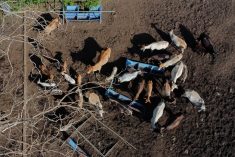Flax producers should pay attention to nitrogen recommendations in soil tests.
They should also reject the myth that flax uses little nitrogen and other nutrients. Those are the main messages of a report called Enhancing Flax Production Through Better Plant Nutrition.
This two-year project, supported by Saskatche-wan Agriculture’s agriculture development fund, was conducted in Saskatchewan’s brown, dark brown and black soil zones. Researchers came from the Agriculture Canada research centres at Scott, Swift Current and Indian Head.
“The objectives of this project were to realize the full potential of flax seed production through proper agronomic practices and optimum fertility using a one-pass direct-seeding and fertilizing system,” said Guy Lafond of the Indian Head research facility.
Read Also

China’s grain imports have slumped big-time
China purchased just over 20 million tonnes of wheat, corn, barley and sorghum last year, that is well below the 60 million tonnes purchased in 2021-22.
“The objectives were met by determining the response of flax to nitrogen, phosphorus, potassium and sulfur by assessing the optimum economic rates and risks of fertilizer application for the various agro-ecological zones of Saskatchewan.”
Of all the nutrients studied, nitrogen had the most consistent effect.
Ken Panchuk, soil specialist with Saskatchewan Agriculture, said this finding should dispel the misconception that flax has low nitrogen requirements.
“Flax, in fact, responds very favorably to the addition of higher rates of nitrogen as based on the recommendation of soil tests,” said Panchuk.
Lafond noted that, in this project, the flax oil content and composition remained stable across all locations and years of the project. There was a small reduction in oil content as the yield increased.
He emphasized producers must ensure proper separation between fertilizer and seed when using a one-pass seeding method.
“Significant reductions in plant populations were observed at all locations with most or all of the effect resulting from the nitrogen fertilizer (urea).”
The report may be viewed on the Sask-atchewan Agriculture website at www.agr.gov.sk.ca by clicking on “research” and going to the agriculture development fund. The report’s number is 96000058.
Copies are also available by calling 306-787-5150 in Regina.














